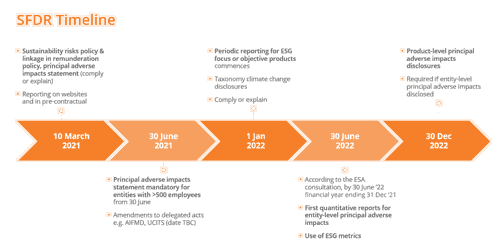Now that the dust has settled on the initial March 10, 2021 deadline of the EU Sustainable Finance Disclosure Regulation (SFDR), you may forgive many investment managers for thinking that they have cleared the latest regulatory hurdle and are on the compliance home straight.
However, March 10 was only the starting point in the ESG race. There are many more hurdles for investment managers to navigate in the months and years ahead. Not only will the requirements of the regulation itself escalate, but also the growing pressure from investors, employees and wider society on investment managers to collect, analyse and report relevant ESG data.
Another 21 months of change
The staggered implementation of the SFDR includes detailed reports and Principal Adverse Impact disclosures throughout 2022. Considerable data will be required to feed into such reports, and managers should consider how they can identify what data is needed, which source to utilise to obtain that data and how much time is needed to collect the data, in order to comply with those obligations in 2022.
And what about non-EU managers? Can they hold off from starting their own ESG race until equivalent regulations are established in their own jurisdictions? To continue the athletics analogy, you would not turn up to the Olympics having done no training. So why try and meet disclosure requirements only as and when they come into effect? Get ahead of the pack and seize the opportunity to start collecting, analysing and reporting ESG data now – institutions cannot report data that they have not yet collected. The cost of retrospectively capturing and analysing data will be far greater than making the commitment to (continue to) capture the data now.
It is important to note that the SFDR applies to any financial market participant or adviser operating, managing or actively marketing their products in the EU - even if they are headquartered outside of the EU. So for those non-EU managers, whether they were ready or not, the ESG starting pistol has already sounded.

A new part of everyday life
The purpose of the SFDR is not to pay lip-service to ESG and carry on as usual. The SFDR has been implemented to integrate sustainability within the core of the investment process, to stamp out ‘green- and purpose-washing’ and to set a precedent for the ESG reporting expectations of investors.
As the requirements of the SFDR increase over time, those who are unprepared and have not implemented sustainable processes and systems will get caught out, overtaken, and left behind in the ESG race. That could ultimately be the difference between securing capital investment and not.
Seize the opportunity
In our recent webinar “ESG - From Niche to Mainstream: A Regulations & Compliance Roadmap” on the requirements of SFDR:
- Only 11% of attendees currently track more than 10 ESG metrics in their underlying investments;
- 28% track some metrics but fewer than 10; and
Surprisingly, 60% currently track no ESG metrics in their underlying investments





